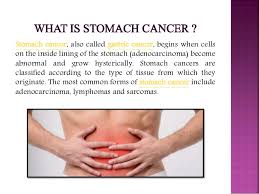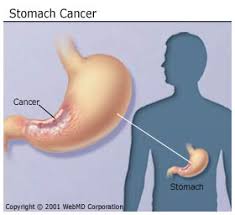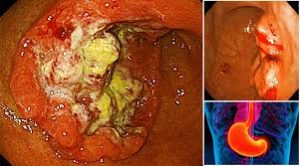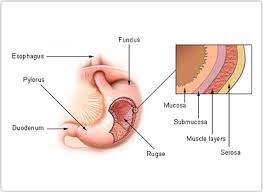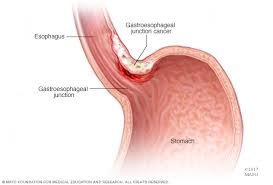Stomach cancer (also called gastric cancer) can develop in any part of the stomach, and may spread throughout the stomach and to other organs. It may grow along the stomach wall into the esophagus or small intestine.
The cancer may also extend through the stomach wall and spread to nearby lymph nodes and organs, such as the liver, pancreas and colon. It may spread to distant organs, such as the lungs, the lymph nodes above the collarbone and to a woman’s ovaries.
Stomach cancer happens when cells start behaving abnormally, growing and proliferating uncontrollably. The stomach, a hollow organ that collects food and breaks it down, has five different parts—from the top of the stomach, which connects to the esophagus, to the bottom of the stomach, which connects to the small intestine:
- Cardia, the area nearest to the esophagus
- Fundus, the upper stomach
- Corpus, the main body of the stomach
- Antrum, where food gets broken down by stomach acid
- Pylorus, which connects to the small intestine
There are also five layers of tissue and muscle that surround the stomach and make up the stomach wall. Going from inner to outer, the layers are:
- Mucosa
- Submucosa
- Muscularis propria
- Subserosa
- Serosa
Stomach cancer progressively spreads through these different layers. Establishing how far within the stomach wall the cancer has spread is a part of the staging process (LIKE all cancers), which determines how serious the cancer is and how best to treat it.
The mucosa layer, which produces stomach acid, is where most stomach cancers begin.
A less common type of stomach cancer is caused by gastrointestinal stromal tumors (GISTs), which start in immature cells called interstitial cells of Cajal.
Other rare stomach cancer types, such as lymphoma and neuroendocrine tumors, start in different cell types in the stomach.
Different types of stomach cancer include:
- Adenocarcinomas develop within the cells of the innermost lining of the stomach. The majority of stomach cancers are classified as adenocarcinomas.Most stomach cancer cases, about 90 percent to 95 percent, are adenocarcinomas, according to the American Cancer Society (ACS).Adenocarcinomas are broken down into two categories:
- Intestinal adenocarcinomas are usually slow-growing and more treatable. Oftentimes, these cancers may be treated with therapy drugs that are designed to target specific mutations in cancer cells. This type most often occurs in men and older adults.
- Diffuse adenocarcinomas are less common than intestinal adenocarcinomas and usually more aggressive. They tend to be faster growing, often spreading (metastasizing) to other parts of the body quickly. This type is more common at a younger age than intestinal adenocarcinomas.
- Lymphoma is a cancer of the immune system tissue that may start anywhere there are lymph tissues, including the stomach. However, lymphomas in the stomach are rare, accounting for about 4 percent of all stomach cancers. MALT (mucosa-associated lymphoid tissue) lymphoma is a type of non-Hodgkin lymphoma that typically occurs in the stomach. The cancer starts in lymph tissue that lines the stomach.
- Gastrointestinal stromal tumors, or GISTs, are a rare type of stomach cancer that starts in a special cell found in the lining of the stomach called interstitial cells of Cajal (ICCs). Under a microscope, GIST cells look similar to muscle or nerve cells. These tumors may develop throughout the digestive tract, but about 60 to 70 percent occur in the stomach. In the United States, 4,000 to 6,000 new GIST cases throughout the GI tract are diagnosed per year, according to the ACS.
- Carcinoid tumors typically start in the hormone producing cells of the stomach. These tumors usually do not spread to different organs and account for only about 3 percent of stomach cancer incidence. About 8,000 gastrointestinal carcinoid tumors are diagnosed in the United States each year, according to the ACS. Not all of these cancers start in the stomach—they may also occur in the intestines, appendix, colon and rectum.
Early stage cancers especially adenocarcinoma(s) may cause:
- Indigestion
- Bloating
- Nausea
- Poor appetite
- Heartburn
As these cancers advanced, they may cause:
- Bloody stool
- Vomiting
- Unexplained weight loss
- Belly pain
- Jaundice (yellowing of the skin and eyes)
- Difficulty swallowing
